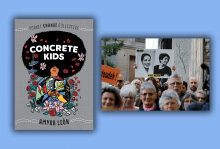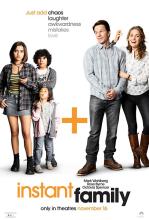foster care

THE WORD “PROPHETIC” gets thrown around a lot in Christian circles. The adjective carries both an ancient heft and a forward-looking fire, the perfect jolt of biblical energy for the nouns that need it: a prophetic book, a prophetic sermon, a prophetic Instagram infographic. But living prophets, especially the self-anointed ones, aren’t so easily marketable. They’re stubborn and strange, somehow arrogant enough to believe they speak for an invisible God who turns out to be, more often than not, extremely angry at large swaths of humanity.
Two-Step Devil, the second novel of rising literary voice Jamie Quatro, places one such character in the contemporary South. Known simply as The Prophet, Quatro’s lonesome protagonist lives in the kudzu-entangled backwoods of northeastern Alabama, where he paints visions of impending holy war on junkyard scraps. He’s the kind of person who can “walk around behind the world’s curtain” — glimpse the spiritual stakes behind the drudgery of familiar, if fragile, social conditions. After rescuing a teenage girl from a sex-trafficking scheme, he’s confident he’s found the one who will deliver his apocalyptic message to the White House. While he’s frail and tormented by self-doubt, she’s young and, in his eyes, innocent. Meanwhile, the girl, Michael, must pull off an urgent mission of her own.

EVANGELICALS AND OTHER Christians involved in adoption and “orphan care” ministries have often evoked Paul’s use of adoption as a metaphor: God “adopts” us into the family of God, so we should adopt children as a manifestation of the gospel.
But New Testament scholar Erin Heim, a U.S. domestic adoptee herself, has raised questions about Pauline adoption metaphors. “The thing that always gets said — ‘contemporary adoption is a horizontal expression of God’s vertical adoption of us’ — there’s something at face value that is a little bit comforting about it, but that doesn’t sit very well for very long,” Heim said in a podcast about her research on these metaphors.
Adoption by nature is a vertical relationship, Heim explained, referring to power inequities between parents and children and between cultures. “There’s no such thing as horizontal adoption,” she said. “When we make mini vertical things that [try to] look like what God does in the Bible, it’s idolatry.”
Christians were pioneers in the establishment of international adoption to the United States in the 1950s and later spurred an orphan care movement during the peak of international adoption in the early 2000s. Since 1948, roughly 1 million children globally have been placed in new families, far from their original families and culture, through intercountry adoption, according to demographer Peter Selman — more than 380,000 of them between 2000 and 2009.
While faith has guided Christians in promoting adoption, religious narratives also have upheld harmful power structures and practices. “White saviorism” and racial hierarchies have led to the separation of children from their cultures of origin. Adoptees who are now adults have shared stories of struggle within families and societies that deny or misunderstand these dynamics.

Captured Behind Bars
Filmmakers in Iran risked arrest to help document Nasrin, a compelling portrait of Iranian human rights lawyer and political prisoner Nasrin Sotoudeh. The film highlights her activism and the power of the Iranian women’s rights movement today. Virgil Films.
Return to the Roots
Who Stole My Bible? Reclaiming Scripture as a Handbook for Resisting Tyranny, by Jennifer Butler, remedies authoritarian misrepresentations of the biblical mandate for justice. This practical guide dissects nine Bible stories and presents tools for embodying faith as liberation. Faith in Public Life.

Some faith-based adoption agencies have a greater ability to adopt antidiscrimination policies than others; nondenominational agencies like Bethany can often change their policies after winning board approval, while Catholic agencies are beholden to Catholic doctrine on same-sex marriage. Due to the structure of the Catholic Church, Catholic adoption agencies would have to shed their Catholic identity to serve LGBTQ couples — something that St. Vincent would likely have had to do.

Keiston Davis regained his life when he almost lost it. Davis was homeless and sleeping in his car in a parking lot of a Charlotte Walmart one night in January 2016 when a group of young men approached the car and ordered him to get out. He was shot in the face as he exited his car. The would-be robbers fled.

Studies show that foster youth are the most likely to drop out of school and least likely to graduate high school, much less attend and graduate from college. In California, about 50 percent of foster students graduated from high school in the 2016-17 school year, compared to about 83 percent for all other students, according to the state Department of Education.

When I was 7 years old, my family began fostering babies. Often these kids would be placed with us after being abandoned just days after they were born. Many of them were never even given a name before their mothers left them at the hospital. When I was about 9 years old, we took in a little boy and his newborn sister. My family eventually adopted them. So, when I screened "Instant Family," starring Mark Wahlberg and Rose Byrne, so many aspects of the movie rang true: The way the foster children acted out, their desire to be with both their birth mother and their foster parents, and how other people reacted to their family. But what also rang true, and it is a story not often told, is how the kids in foster care are not solely defined by their trauma or their status as “foster kids.”

I know that this child’s life and mine have intersected by a miraculous plan, and that however temporary, we will both enjoy what we can from how our stories have come together. He tells me stories of what it was like at his birth family’s house, we talk about the differences and similarities between his birth household and my household now, and together we make more crazy plans.
God calls us among all of our anxieties, voiced and unvoiced, to keep on living. To pray for one another, to argue with one another, to take the terrifying chance to say “I love you” to one another every day because we know the other needs to hear it.

Raising Themselves
The film Know How, a musical written and acted by foster-care youth, tells interwoven stories of coming of age within a dysfunctional system, the losses and dangers these young people face, and their against-the-odds struggle to persevere. First Run Features
Beyond the Food Drive
In Charity Detox: What Charity Would Look Like If We Cared About Results, Robert D. Lupton asserts that poverty must be addressed “through development, not through one-way giving.” With anecdotes and examples, he explains development strategies such as fund reallocation, reciprocal exchange models, and neighborhood reconciliation. Harper One

Author's Note: This hymn is written with gratitude for foster parents, social workers, and others who do seek to do their best for abused and neglected children and youth. It is written as a prayer for the many children and youth who are failed by a broken system that too often ignores their cries and rights. Parts of this hymn, especially, are written as a prayer for one small boy who was our foster son for nineteenth months and is no longer in our care, but who will always be in our hearts. Sojourners' January 2014 issue had several helpful articles on foster parenting.
Lord, Hear the Cries of Children
PASSION CHORALE 7.6.7.6 D (“O Sacred Head, Now Wounded”)
Lord, hear the cries of children who struggle every day,
Caught up in failing systems that steal their hope away.
Some find they’re lost to violence, then lost in foster care.
They long for life’s abundance! Lord, hear their pleading prayer.
Follow the gripping story of a young girl taken from her home and placed into foster care.

As a mental health professional and a mom, I have come to appreciate the incredible importance of family relationships on the development and maturation of children. I’ve also realized that the archetypal family relationships worshipped in our (Christian and secular) culture often have little to do with the real sweat and blood of family life.
My husband and I have a running joke that one day we will start an “ambiguous family relationships” greeting card company. Our imaginary company is designed for those experiencing family situations that aren’t exactly addressed on the cheerful card aisle. Mother’s Day is prime among those occasions that seems to call for our imaginary company’s services. While the consumerist culture portrays images of wonderful family relationships rewarding the hardworking mom with leisure and jewelry, Mother’s Day is not joy and leisure for all. It can be a time of irony and pain for those who have experienced relationship loss, infertility, miscarriage, separation, or death. Mother’s Day in many ways has become a cultural enforcement of the middle class ideal rather than recognition of the real pain and sacrifice of mothers worldwide.
FROM EGG FREEZING to genome analysis, desirous parents with sufficient funds these days have many choices for starting a family. But what about children born to parents who can’t care for them—at least not at the present time? With 400,000 children in foster systems across the United States and a quarter of them awaiting adoption, it is a pressing question.
Some evangelicals increasingly are taking their cue from a particular biblical passage in the first chapter of James, verse 27: “Religion that is pure and undefiled before God ... is this: to care for orphans and widows in their distress ...”
From this verse has come the “127 movement,” dedicated to supporting prospective foster families within a church community. Project 1.27 in Colorado was the first group founded under this banner back in 2004. Its goal was to provide the state-mandated orientation and training, from a Christian perspective, to potential foster parents. If a family ended up fostering or later adopting a child, then the movement’s members would serve as a support network.
“We had 875 legally free kids waiting to be adopted in Colorado and twice that many churches,” recalled Project 1.27 director Shelly Radic. “We thought, ‘Wow, that’s just not right,’ so we began to build relationships with county social services and child services at the state level, and then connect with churches and private agencies to set up training.”
Since foster systems are run by individual states, so too are these faith-based support movements.
“We do recruiting, orientations, and training. We’re not a placement agency,” explained Radic. “We follow state guidelines, invite people to come who might be interested in foster care and adoption, tell them about the trauma and the hard things the children may have experienced, help families see what their process would look like, and talk about building a support team as a high priority.”
Resources that help address the modern-day "orphans in distress" in our midst

I WAS 7 years old when my family first opened our home to foster children. My parents were in their early 40s and already had four children at home. They were somewhat typical for foster parents at that time: married, established, often people of faith. We had a total of 10 children in our home—two of whom were adopted—from 1988 until 1997. Fostering children was a 24-hours-a-day, seven-days-a-week commitment and calling. As my mother would say, “God sets the lonely in families—but am I willing to let him set them in mine?”
This is a question that more Christians—particularly the oft-maligned Millennials—are asking themselves. They are examining both the sheer number of children growing up without families and scripture to see what it says about their faith. Taking their cue, and often their names, from James 1:27 (“look after orphans and widows in their distress”), groups in Colorado, Arizona, Oklahoma, Virginia, and most recently the District of Columbia have committed to looking after these modern-day “orphans in their distress.”
According to the Administration for Children and Families, in 2012 there were 400,000 children in foster care nationwide. Of that number, 102,000 were waiting to be adopted. Only 52,000 children were adopted in 2012; at the end of 2011, 15 percent of youth in the system lived in group homes or institutions. What is most troub-ling is the number of youth who “age out” of the system every year without the support of a family. At the end of 2011, 11 percent, or 26,000 youth in the system, aged out. These youth are much more likely to experience homelessness, health problems, unemployment, incarceration, and other trouble later in life.

"Foster care touches on multiple issues and engaging the system is a way to comprehensively engage some of the biggest challenges to a city’s flourishing."
There is a new initiative in Washington, D.C. that hopes to so profoundly change the foster care system in the city that the supply of foster homes will far exceed the demand for them. DC127 is an organization committed to “reversing the list” of children and youth who are waiting for a foster or adoptive home. By reminding churches of the biblical mandate to care for widows and orphans, they have started a network in D.C. that spans Christian denominational lines.
The movement is beginning to gain some traction and DC127 is gearing up for its first event on November 2.

Jesus flips things upside down. DC 127 plans to follow suit.
The Washington, D.C.-based foster care initiative created by the District Church seeks to reverse the foster care waitlist in our nation’s capital, leaving parents waiting to foster the 3,000 children currently on the list instead of children waiting to be taken in by families.
“The heart behind DC 127 is to reflect God’s heart,” said District Church Lead Pastor Aaron Graham. “We believe there are no orphans in heaven. And Jesus taught us to pray, ‘your kingdom come, your will be done on earth as it is in heaven.’ And so our prayer is that we would reflect God’s heart, who’s adopted us, by helping adopt and foster kids in D.C.”
The first few nights weren't so bad. It was on the fourth night, the night it rained, that it got to me. I had just spent the past week sleeping on the sidewalk in front of the Illinois state Capitol building in Springfield. Throughout the week, young people of faith, college students, as well as homeless and formerly homeless youth traveled from Chicago to Springfield. Some slept on the sidewalks at night, and others came solely to lobby their legislators. We were all there for the same reason -- because each year nearly 25,000 youth experience homelessness in the state of Illinois. Not only were there not the resources to help these youth, but most legislators and most of the general public didn't even realize the problem existed.
In the past few weeks, I've written about a lot of full-page ads. This full-page ad is different. Too often, homeless youth have been invisible. The Ali Forney Center, a service provider for LGBT homeless youth, has a full-page ad in this month's issue of Sojourners magazine. GLAAD, the Gay and Lesbian Association Against Defamation, connected the Ali Forney Center to Sojourners, as a part of an advertising campaign the Ali Forney Center is running. The ad highlights that up to 40 percent of homeless youth identify as lesbian, gay, bisexual, or transgender. I have talked with many teens who became homeless because they were kicked out of their homes or ran away from abuse by their parents because of their sexual identity. After their homes became dangerous, they went to the streets, where many were attacked and some were trafficked or forced into prostitution.
"I do the work of justice not out of a disdain for the privileged but out of a love for Life." - Womanist Theologian Dr. Kelly Douglas Brown